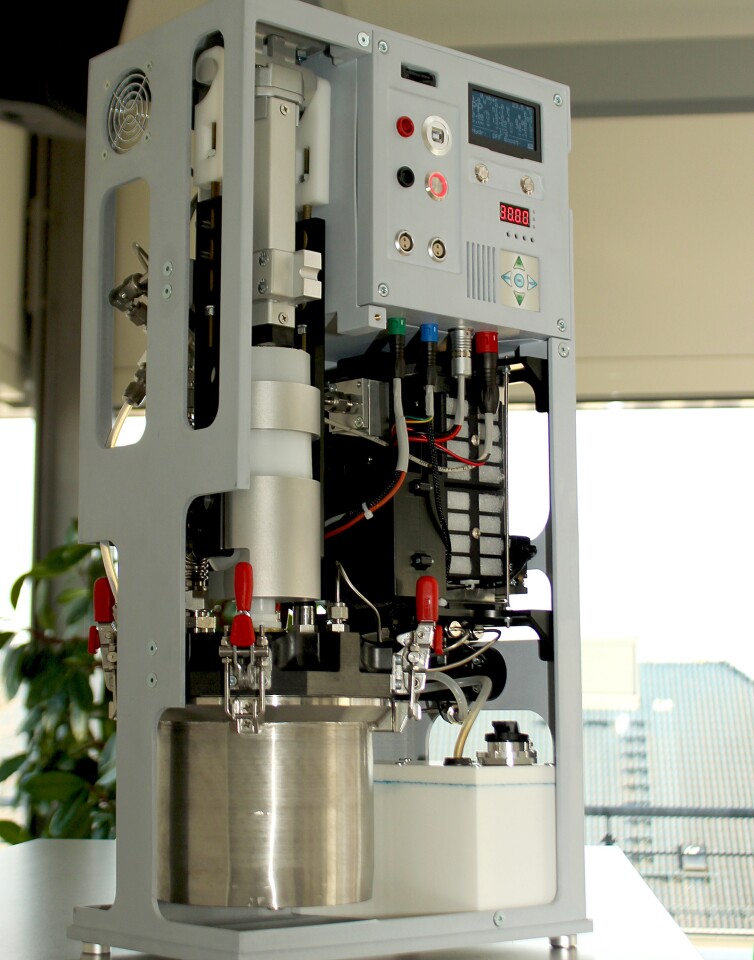Fraunhofer researchers have offered a magnesium-based “Powerpaste” that outlets hydrogen electricity at 10 situations the density of a lithium battery, presenting hydrogen gasoline cell automobiles the means to vacation even further than gasoline-driven ones, and refuel in minutes.
Generally, of class, hydrogen fuel cell automobiles carry their H2 gasoline in gaseous variety, saved in tanks at pressures all around 700 bar (10,150 psi). These tanks are relatively huge and major, which counteracts a single of hydrogen’s essential positive aspects over today’s lithium batteries – its greater electrical power density. The higher pressures associated also make hydrogen an impractical solution for powered two-wheelers like motorcycles and scooters.
But a staff centered at the Fraunhofer Institute for Producing Technologies and Innovative Materials IFAM in Dresden have come up with an appealing new way to shop and carry hydrogen energy, in the variety of a magnesium hydride-dependent “Powerpaste” that outlets the hydrogen in a chemical type, at atmospheric pressure, completely ready for launch when required.
To develop the paste, magnesium is merged with hydrogen at around 350 °C (662 °F) and 5 to six instances atmospheric stress to variety magnesium hydride. An ester and a steel salt are additional to entire the approach and kind a viscous grey goop that can be loaded into cartridges.
In Powerpaste form, it truly is completely steady at temperatures up to 250 °C (482 °F). It carries 10 periods the electrical power of a related bodyweight in lithium batteries, and considerably extra than a 700-bar H2 tank of the exact same bodyweight. The researchers say motor vehicles managing on a Powerpaste powertrain can anticipate a range “equivalent to – or even bigger than – gasoline.”
When it will come time to release the energy, a plunger mechanism extrudes the paste into a chamber the place it reacts with water to launch hydrogen at a dynamically controlled fee, which then feeds a gas mobile to develop electrical electric power with which to run an EV powertrain or other system. Portion of the paste’s spectacular vitality density arrives from the reality that half of the hydrogen unveiled comes from the water it reacts with.

Fraunhofer IFAM
Refueling a Powerpaste scooter, for example, would be a subject of pulling out the cartridge and replacing it with a entire a single at a assistance station. In this way, this stuff could grow to be anything like a bottle of BBQ fuel: an simply replaceable way to use thoroughly clean electrical power in a range of gadgets. The Fraunhofer staff speaks of employing it in big drones, placing a multiplier on their flight time and variety, or in portable electrical appliances, this kind of as a paste-driven tenting toaster or kettle, for example.
And where by removable cartridges may well be just the ticket for some programs, other folks may well find it a lot easier just to pump the things into a tank – for illustration, fuel cell vehicles and trucks, aircraft and more substantial applications. The staff claims this sludgy goop can be supplied through typical filling lines with “fairly low-cost equipment.”
Logistically, this stuff seems a lot less complicated than standard gaseous (and definitely liquid) H2. It can be trucked all-around in barrels or tankers, and remaining far more or much less wherever with out danger. Fraunhofer IFAM is making a Powerpaste output plant at its individual services, which will open later this year and have the ability to make up to four tons of paste a yr for pilot applications and field analysis. It also has a electric power generator up and operating on the test bench in the lab.
Queries continue to be, while. What takes place to the magnesium as the paste is used? Does it get recycled back again into the method? Do the energy density figures quoted over acquire into account the entire program needed, or just the gasoline storage? How substantially drinking water does it use for a offered volume of energy, and how significantly drinking water do you want to add when you fill up, offered that fuel cells produce drinking water as a by-products?
Perhaps most importantly, how vitality-effective is the approach of earning this paste? Let’s not neglect, one of the black marks from clean up hydrogen in fuel cell programs is its horribly inefficient use of clear vitality. Retail store clear electricity in a battery and you will get far more than 90 per cent of it again at the wheels. Retail store it in hydrogen and you torch at minimum fifty percent of it in lossy procedures along the way.
The output of Powerpaste necessitates heat, pressure and industrial procedures, all of which expense energy. Include to that the monetary and electricity expenses of storage and transportation, and the equations are very likely to make gaseous H2 search like a extremely frugal minimal strength holder by comparison.
As extensive as Powerpaste is generated employing very little but clear vitality, it even now seems like a cleanse gasoline – and potentially a very easy 1 that we can imagine rolling out to fuel stations with no way too considerably fuss. But in a entire world in which clear electricity manufacturing is even now minimal, it may perhaps end up seeking like a wasteful use of our photo voltaic and wind resources.
And then there is certainly the subject of price how will Powerpaste compare to gasoline on a fill-up, presented that it’ll produce about the very same variety? Unquestionably, it’s going to be a whole lot to start with and would appear down with scale and the price of clean H2. But the added processing and transportation expenditures will make it a lot more pricey than straight hydrogen fuel, and a ballpark long term figure could unquestionably be instructive. We are going to set these queries to the scientists and see how items begin to stack up.
Resource: Fraunhofer

:max_bytes(150000):strip_icc()/house-cleaning-schedule-for-every-day-3129149-06-b23eacd9ef3a41fc833c68e095b34c72.jpg)



More Stories
Living Room Trends 2023 To Jazz Up Your Home
David Selinger, CEO of Deep Sentinel
How to prepare your home for a cat